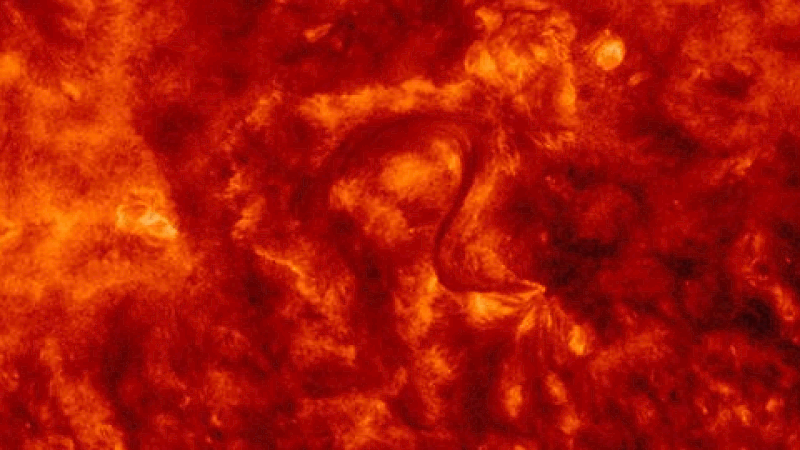Gigantic ‘letter S’ spotted on the sun just before a ‘dark eruption’ hurls a fiery shadow at Earth
By Harry Baker
Copyright livescience

Skip to main content
Close main menu
Live Science
Sign up to our newsletter
View Profile
Search Live Science
Planet Earth
Archaeology
Physics & Math
Human Behavior
Science news
Life’s Little Mysteries
Science quizzes
Newsletters
Story archive
Bright orange shark discovered
Egyptian queen coin found in Jerusalem
Do humans and chimps share 99% DNA?
Comet 3I/ATLAS’s tail growing
Blood moon in photos
Don’t miss these
Bottom of the sun becomes visible to humans for the first time in history (photos)
Scientists unveil most detailed photo of a solar flare ever taken
‘Never been seen before’: First images from new ISS solar telescope reveal subtle ‘fluctuations’ in sun’s outer atmosphere
NASA spacecraft snaps images of lunar transit and Earth eclipse on the same day — see the photos
Powerful solar telescope unveils ultra-fine magnetic ‘curtains’ on the sun’s surface
Black Holes
Giant, cosmic ‘Eye of Sauron’ snapped staring directly at us in stunning 15-year time-lapse photo
Parker Solar Probe captures closest-ever photos of the sun during record-breaking flight
Friday the 13th solar storm could bring auroras to 18 US states this weekend
‘Space hurricane’ caught raging over North Pole during one of the sun’s quietest days
Scientists detect gargantuan ‘pimple’ that has plagued a star for at least 7 years
Auroras may be visible from 18 states this weekend as solar storm barrels toward Earth
Sun ‘hole’ expected to produce intense auroras tonight, potentially visible from 15 US states
‘A completely new phenomenon’: Astronomers spot a planet causing its star to constantly explode
Artificial Intelligence
IBM and NASA create first-of-its-kind AI that can accurately predict violent solar flares
Behold! 1st images of artificial solar eclipse captured by ESA’s Proba-3 mission
Gigantic ‘letter S’ spotted on the sun just before a ‘dark eruption’ hurls a fiery shadow at Earth
Harry Baker
9 September 2025
A giant S-shape structure, around 10 times wider than Earth, recently appeared in the center of the sun, moments before our home star unleashed an even larger plume of plasma that later crashed into our planet.
When you purchase through links on our site, we may earn an affiliate commission. Here’s how it works.
A striking S-shape structure, up to 10 times wider than Earth, emerged on the sun’s surface before a solar flare launched a “dark” CME at Earth.
(Image credit: NASA/SDO)
A gigantic, backwards “letter S” recently appeared slap bang in the middle of the sun, moments before our home star unleashed a massive plume of plasma that later smashed into Earth, temporarily disrupting our planet’s magnetic field.
The bizarre S-shaped structure, which bears a resemblance to the iconic symbol of Superman, took shape on Sept. 4, less than an hour before an M-class solar flare launched a giant magnetized cloud of plasma stretching up to 435,000 miles (700,000 kilometers) across, Spaceweather.com reported. This plasma plume, known as a coronal mass ejection (CME), appeared dark against the sun’s surface because its plasma is significantly cooler than its surroundings, similar to why sunspots appear black.
This “dark eruption” smashed into Earth’s magnetic field, or magnetosphere, on Sunday (Sept. 7), temporarily disturbing our planet’s protective shield. This disturbance, known as a geomagnetic storm, occurred around the same time as a “blood moon” total lunar eclipse, which was visible across large parts of the globe. However, the storm only reached G1 (minor) status, meaning it did not generate many visible auroras in the U.S. or at similar latitudes, according to Live Science’s sister site Space.com.
You may like
Bottom of the sun becomes visible to humans for the first time in history (photos)
Scientists unveil most detailed photo of a solar flare ever taken
‘Never been seen before’: First images from new ISS solar telescope reveal subtle ‘fluctuations’ in sun’s outer atmosphere
This rare type of solar outburst is known as a “sigmoid eruption,” named after the Greek letter sigma, which corresponds phonetically to “S” in English. In this case, the “S” appeared just above the sun’s equator, right in the center of the hemisphere facing Earth, and was roughly 78,000 miles (125,000 km) across at its widest point — around 10 times the diameter of Earth.
Related: A mysterious, 100-year solar cycle may have just restarted — and it could mean decades of dangerous space weather
The CME looked like a giant shadow as it shot out of the sun and has since collided with Earth. (Image credit: NASA/SDO)
Sigmoid eruptions occur when the localized magnetic fields surrounding sunspots get twisted up “like a slinky” at each end of the bar that runs through their center, causing the entire structure to snake, according to Spaceweather.com.
The shape makes it almost certain that the sunspot will create a solar flare because the magnetic field holding it together more readily snaps when the opposite ends of the magnetic field are closer together, flinging plasma away from the sun in the process, Spaceweather.com representatives added. “When you see an ‘S’ on the sun, it usually means something is about to explode,” they wrote.
Sign up for the Live Science daily newsletter now
Get the world’s most fascinating discoveries delivered straight to your inbox.
Contact me with news and offers from other Future brandsReceive email from us on behalf of our trusted partners or sponsorsBy submitting your information you agree to the Terms & Conditions and Privacy Policy and are aged 16 or over.
A similar structure was also seen shortly before a supercharged X9.3 magnitude solar flare in September 2017, which, at the time of the event, was the most powerful solar explosion in almost a decade, according to a 2024 study.
The S-shape structure appeared almost exactly in the center of the Earth-facing hemisphere of the sun. (Image credit: NASA/SDO)
Researchers first noticed the explosive potential of sigmoid eruptions in the late 2000s. However, they are still trying to work out exactly what causes them to take this shape.
The classical explanation for the S shape is that it emerges when two J-shape structures — the most common shape that precedes solar flares — merge end-to-end into a single entity. However, a 2022 study hinted that it is more likely that a single J-shape structure is transformed into an S via “slipping” of its associated magnetic field.
Increased solar activity
Solar activity has been peaking over the last few years due to the solar maximum — the most active phase of the sun’s roughly 11-year solar cycle, when the number and size of sunspots and solar storms rise sharply.
This explosive peak was initially predicted to be fairly tame compared to recent solar maxima. However, the initial forecasts were inaccurate, and the current maximum arrived early and has been far more active than expected.
RELATED STORIES
—Behold, ‘The Beast’: Gigantic animal-like plasma plume 13 times wider than Earth hovers over the sun
—Giant ‘senior citizen’ sunspot on 3rd trip around the sun could break a century-old record
—Astrophotographer snaps ‘once-in-a-lifetime’ shot of solar flare photobombing the ISS
Solar maximum has now likely come to an end. However, solar activity is expected to remain relatively high in the coming months due to continued instability within our home star’s magnetic fields.
The last few weeks have seen a mini-resurgence in space weather events, including a giant “solar tornado” that raged above the sun’s surface for several days in late August, and a “cannibal” CME that painted auroras above multiple U.S. states on Labor Day (Sept. 1).
solar maximum
Harry Baker
Social Links Navigation
Senior Staff Writer
Harry is a U.K.-based senior staff writer at Live Science. He studied marine biology at the University of Exeter before training to become a journalist. He covers a wide range of topics including space exploration, planetary science, space weather, climate change, animal behavior and paleontology. His recent work on the solar maximum won “best space submission” at the 2024 Aerospace Media Awards and was shortlisted in the “top scoop” category at the NCTJ Awards for Excellence in 2023. He also writes Live Science’s weekly Earth from space series.
You must confirm your public display name before commenting
Please logout and then login again, you will then be prompted to enter your display name.
Bottom of the sun becomes visible to humans for the first time in history (photos)
Scientists unveil most detailed photo of a solar flare ever taken
‘Never been seen before’: First images from new ISS solar telescope reveal subtle ‘fluctuations’ in sun’s outer atmosphere
NASA spacecraft snaps images of lunar transit and Earth eclipse on the same day — see the photos
Powerful solar telescope unveils ultra-fine magnetic ‘curtains’ on the sun’s surface
Giant, cosmic ‘Eye of Sauron’ snapped staring directly at us in stunning 15-year time-lapse photo
Latest in The Sun
‘Cannibal’ solar storm could paint auroras above 18 US states this Labor Day
Scientists unveil most detailed photo of a solar flare ever taken
Solar tornado rages on the sun as a giant plasma plume erupts
NASA spacecraft snaps images of lunar transit and Earth eclipse on the same day — see the photos
Behold, ‘The Beast’: Gigantic animal-like plasma plume 13 times wider than Earth hovers over the sun
Parker Solar Probe captures closest-ever photos of the sun during record-breaking flight
Latest in News
Scientists are finally learning what’s inside mysterious ‘halo’ barrels submerged off Los Angeles
Gigantic ‘letter S’ spotted on the sun just before a ‘dark eruption’ hurls a fiery shadow at Earth
Microsoft’s new light-based computer is inspired by 80-year-old technology — it could make AI 100 times more efficient
‘Extraordinary’ Roman helmet from war-ending battle found in the sea off Sicily
New photos of comet 3I/ATLAS reveal its tail growing before our eyes
‘Blood moon’ gallery: Stunning snaps from last night’s total lunar eclipse
LATEST ARTICLES
Scientists are finally learning what’s inside mysterious ‘halo’ barrels submerged off Los Angeles
Microsoft’s new light-based computer is inspired by 80-year-old technology — it could make AI 100 times more efficient
I watched scientists view the interstellar comet 3I/ATLAS in real time. Here’s what they saw.
Giant ‘chessboard’ surrounds Idaho river in bizarre astronaut photo
‘Extraordinary’ Roman helmet from war-ending battle found in the sea off Sicily
Live Science is part of Future US Inc, an international media group and leading digital publisher. Visit our corporate site.
Contact Future’s experts
Terms and conditions
Privacy policy
Cookies policy
Accessibility Statement
Advertise with us
Web notifications
Editorial standards
How to pitch a story to us
Future US, Inc. Full 7th Floor, 130 West 42nd Street,
Please login or signup to comment
Please wait…



